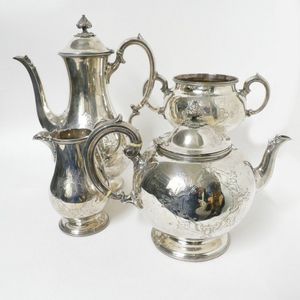1867 Birks Sterling Coffee Set with Embossed Decoration
You must be a subscriber, and be logged in to view price and dealer details.
Subscribe Now to view actual auction price for this item
When you subscribe, you have the option of setting the currency in which to display prices to $Au, $US, $NZ or Stg.
- Embossed / Repousse - Embossing, also known as repousse, is the technique of decorating metal with raised designs, by pressing or beating out the design from the reverse side of the object.It is the opposite of chasing, where the decoration is applied from the front. An embossed or repoussed object may have chasing applied to finish off the design.
- Hallmarks - A mark stamped on articles of precious metals in Britain, since the 14th century, certifying their purity. It derives its name from the Guild Hall of the Goldsmiths' Company, who recieved its Charter in 1327 giving it the power to assay (test the purity) and mark articles of gold and silver.
The hallmark will consist of several marks, including the:
- silver standard mark, indicating the purity of the metal. Sterling silver is .925 pure silver.
- the city mark indicating the city in which it was assayed eg London, Birmingham, York etc.
- the date mark, usually a letter of the alphabet in a particular font and case,
- a duty mark, indicating whether duty had been paid to the crown, and only in use from 1784 to 1890
The piece may include an additional mark, the maker's mark, although not forming part of the hallmark, will be located in the vicinity of the hallmarks.
Sometimes silver plated items will bear faux hallmarks, often confusing those not familiar with silver markings. - Circa - A Latin term meaning 'about', often used in the antique trade to give an approximate date for the piece, usually considered to be five years on either side of the circa year. Thus, circa 1900 means the piece was made about 1900, probably between 1895 and 1905. The expression is sometimes abbreviated to c.1900.
This item has been included into following indexes:
- coffee sets/services - silver items 412
-
tea sets/services
- silver, four piece 301
- silver, Victorian 306
Visually similar items

A Danish 830 silver, 3pcs coffee set, late 1930's, comprising of coffee pot, milk jug and sugar bowl. Stamped with Danish silver assay and monogram 'Cj' to base. Coffee pot height 24 cm. Total weight 815grams

An English eighteenth century sterling silver baluster coffee pot by William Shaw & William Preist, London 1762, with a mythical bird to the top of the spout and mask head to the base, the coffee pot features elaborate decoration including a double scroll

A Victorian silver four-piece tea and coffee service, the coffee pot with plain baluster body, the teapot of bullet shape, conforming sugar basin and milk jug, all with engraved vacant cartouches. Sheffield 1868 by Martin Hall Ltd. Total weight 2228gm

George III sterling silver mug, hallmarked London 1775, maker Charles Wright, plain baluster mug, height 13 cm, 408 grams approx.
